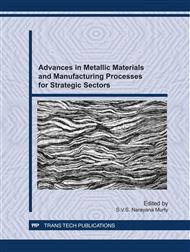p.433
p.439
p.445
p.451
p.457
p.463
p.471
p.477
p.483
Tensile Behaviour of Al-Si Alloy and Al-Si/Graphite Composites at Elevated Temperatures
Abstract:
The high temperature tensile behaviour of Al-Si alloy and two of its composite systems with graphite as major reinforcement were investigated. The composites were developed by the stir casting method, wherein a mixture of graphite (3 wt %) and Cu / Ni (2 wt% each) were added into the molten Al-Si alloy to fabricate two systems such as Al-Si-Cu/graphite composite and Al-Si-Ni/graphite composite. The properties of composites were better than that of the matrix alloy. Tensile behaviour of alloy and composites were studied at different temperatures from room temperature to 300°C. It is found that the tensile strength of the alloy and composites were decreasing with increase in temperature. The transition elements (Cu / Ni) have played the key role in improving the ultimate tensile and yield strength of the composites over the alloy. The flow stress of the composite is more than that of the alloy. The strain hardening exponent value continuously drops with the increase of tensile temperature due to the thermal softening effect. The % elongation of the alloy is more than that of the composites. Fracture surfaces of the samples are analyzed by scanning electron microscope to understand the fracture mechanisms. Fractography reveals that the fracture behaviour of the alloy changes from cleavage mode at room temperature to complete ductile mode at high temperature.
Info:
Periodical:
Pages:
457-462
Citation:
Online since:
January 2012
Authors:
Keywords:
Price:
Сopyright:
© 2012 Trans Tech Publications Ltd. All Rights Reserved
Share:
Citation:


